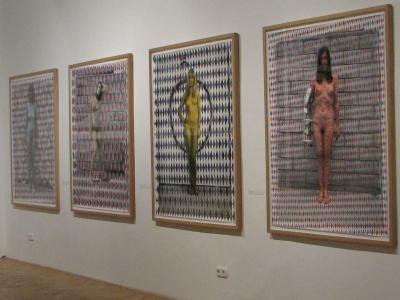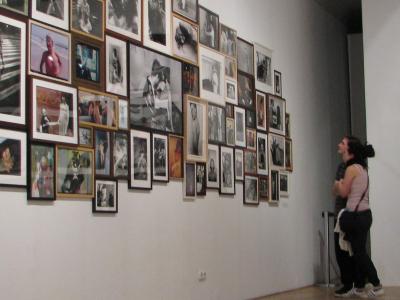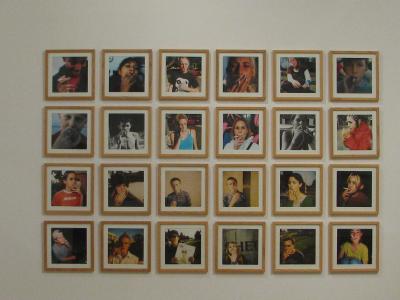Lifestyle Advice from a Californian Boy
To be honest, my head was full of preconceived ideas when I arrived at the latest exhibition at the Ernst Museum. “An American skater boy shouldn’t dabble in art”, and “every man to his trade” and, “what kind of an artist might such a reckless and frivolous guy possibly be” and so on, I could continue listing ideas related to the exhibition that were far from being positive.
It is true, though, that the manager (currently ex-manager) of Műcsarnok had been daring enough to accept Ed Templeton’s material and provoke an audience which had formed explicit opinions on high art.
The very question sounds as follows: is he a skateboarder or an artist? And he is both, or even more. Ed Templeton was born in 1972 and raised near Los Angeles, in Orange County. It was a cornerstone in his life that he made a living as a professional skateboarder from an early age, and then, at the age of 21, he established the Toy Machine Bloodsucking Skateboard Company, and designed artwork for its products. However, visual art was not a sudden fancy for Ed Templeton; he had been painting, drawing and taking pictures for several years. The uniqueness of his art is not only provided by his themes but also, by the great diversity of techniques: in his works photos and paints are brought into harmony with metallic surfaces as well as with excerpts from poetry.

The unity of the exhibition hall itself evokes a sense of entirety. Since the old and new works of the artist are mixed and are not divided in rigid chronological order, we are able to “read” lessons of an incomplete life in the pictures. There is no sign of favouritism or glitter in them rather they show the life of ever-travelling skateboarders on the road by scenes which are often depressing, such as the landscapes seen through the window while travelling on endless highways, or bleak hotel rooms as well as pictures of inanimate suburban streets. The following warning can be found in reports about the exhibition: “Some of the pictures on display may contain nudity, sex or sex-related behaviour, therefore the exhibition is not advised for those under the age of 18”, which may also remind us of the fact that sexuality and nudity are also among the themes of the works, for both play a significant role in Ed’s life, though his main subject is his wife Deanna who not only accompanies him to his skateboard events but also takes part in the process of creating his artworks and exhibitions.
On leaving the exhibition I felt disappointed but pleasantly so, because my preconceived ideas had been completely destroyed. Rarely can one see an artist let his audience so close to his thoughts, his life and his immediate environment. Thanks to his profession, Ed Templeton visits thousands of countries, meets thousands of people, and documents his experience with the precision and expertise of a sociologist. The faces appearing in his series of portraits showing youngsters smoking are ordinary faces and we could easily meet any of them in the streets of Budapest as well: therefore frontiers and distances disappear in his pictures and, though these youngsters are American, in their facial features we may discover our own teenage struggles and the fight to belong to a group at any cost. Although the artist often uses poems and explanatory texts, for instance in the case of his larger than life sculptures, words become unnecessary here since everything can be seen in the faces.

We can come even closer to the world surrounding Ed Templeton by the stream of these photos which takes possession of the walls. The seemingly never-ending line of black-and-white photos which just crawls round and round the walls shows an indiscriminate chaos at first sight, but in fact reveals the crumbs of a man’s life, moments that are at times important, and at other times less dominant. But who is to decide what is important and what is not? A single picture in itself may seem almost lifeless, insignificant, but together with the rest, with the other scenes of Ed’s life, we might get acquainted with the story of a life and a feeling, an impression, creeps almost unnoticeably, into the deepest depths of our consciousness: there are insights hiding beneath the surface of the reckless and rowdy skater boy, the insights of a contemplative man familiar with life.
The exuberant life and dynamism, however, does not only get absorbed into the photos that crawl over the walls, but the video recordings as well, which can be seen in the “coating” of a separated area. The discerning visitor is about to face yet another challenge. Why should I be watching these idle adolescents and the already ageing skater workers? What's in it for me? Anyway just sit and watch! And as the photos imperceptibly reveal the thoughts of a “philosopher”, familiar with the way of world, so do these idlers propose to us an eternal truth: a clear image almost burning into our minds of a an ever-falling man, who stands up and tries again and again.

Although it may seem unusual for a visitor to go and see an exhibition full of resistance in advance, I believe that the very person of the artist will arouse prejudice in many people. Although Ed Templeton has been drawing and painting for years, and has chosen classical analogue photography despite the existence of widespread digital technique, it is very likely that people will be unable to set aside the fact that he is simply an American skater boy. But that is what we humans are like… we simply judge without first having experienced the thing we are to pass judgement on. This situation is made worse by the fact that street art or graffiti has not been able to receive a place in the so-called Acropolis of high art in our beloved country.
In our eyes, so accustomed to classical art, these drawings, statues, paintings and photo montages at first might seem childish and without elaboration, but I, after all, find the diversity of genre and technique fascinating as well as the courageous way in which Ed uses different techniques and materials. But how could he be content to use only one material, when his topic, which permeates and composes his work, is life itself, the colourful life that surrounds him, and in which beauty (which does not appear in a flawless form) and filth, poverty and consumer’s goods all have their places.
The exhibition can be visited at the Ernst Museum, from January 22 to March 20, 2011.
Curator: Thomas Caron
You can find out more about his art on his website, where you will also find the photos made of his visit in Hungary.
(translated by Zita Kassai and Anna Szelényi)



Facebook-hozzászólások